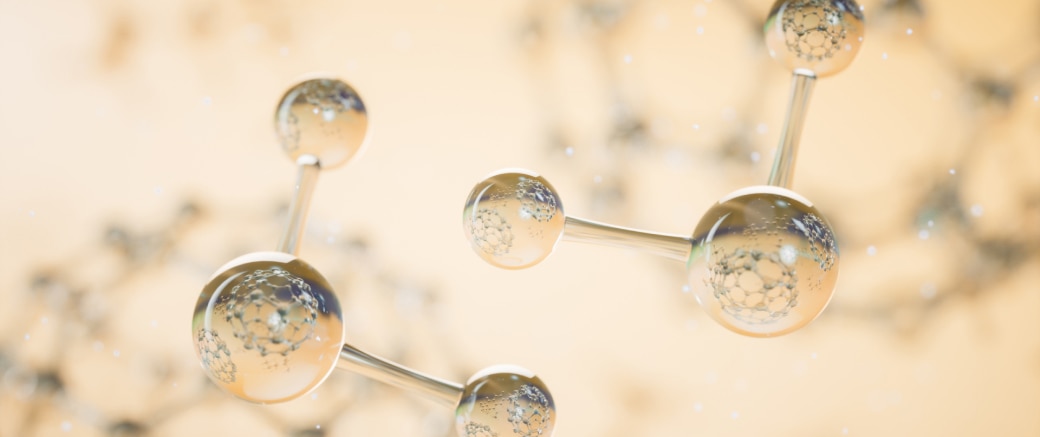Mass Spectrometry Guide
Principle, Components, Applications and More
Understanding Mass Spectrometry Principle and Applications

Mass spectrometry (MS) is an excellent technique for analyzing substances, which allows the identification of components in a sample by measuring the masses of molecules.
Generally, mass spectrometry consists of three steps: “ionization”, “mass separation”, and “detection”.
Ionization is a process by which molecules become charged (charged molecules are called ions). The generated ions have a physical quantity called the mass-to-charge ratio, i.e. the mass of the ion divided by its charge.
During mass separation, gas phase ions can be separated according to the mass-to-charge ratio in a vacuum vessel by electric or magnetic fields. Finally, those separated ions arrive at the detector and are observed as individual signals.
Electric or magnetic fields affect the motion of ions in the vacuum because the ions have electric charges.
The ions are accelerated by applying a voltage and fly in a straight line. As the ions subsequently pass through the magnetic field, they are forced by the magnetic field to bend their orbits. The degree of bending depends on the mass-to-charge ratio of the ion.
In other words, by precisely setting the electric field or magnetic field, it is possible to determine the mass-to-charge ratio of ions of interest or to detect the ions of a specific mass-to-charge ratio.
Of note, the motion of ions in a vacuum is solely determined by a physical quantity of mass-to-charge ratio and has nothing to do with the chemistry of the original molecules.
Applications of Gas Chromatography Mass Spectrometry (GCMS)
Mass spectrometers are used for a diverse range of applications. Below in the table are some examples where gas chromatography (GCMS) is used in various industries, from clinical research to pharmaceutical, environment, food, petrochemical, and more.
GC is a technique that vaporizes the sample mixture into gaseous compounds and separates them based on the boiling point of the compounds and their differential adsorption on a porous solid or liquid support. It is commonly used for the analysis of low molecular weight and volatile compounds and is widely applicable in many industries such as forensics, food, environmental testing, pharmaceuticals, petrochemicals, pesticides, and fragrances.
In the mass spectrometer, the ion source converts the gaseous compounds into charged ions by means of electron bombardment or collision/reaction with a reagent gas. Electron ionization (EI) and chemical ionization (CI) are the main ionization modes used in GCMS.
| Clinical Research / Forensics | - Steroid and drug analysis |
|---|---|
| Pharmaceutical | - Impurities and residual solvent analysis |
| Environment | - Analysis of volatile environmental pollutants |
| Food & Beverage | - Analysis of pesticides, additives and contaminants - Analysis of aromatics in wine and coffee |
| Oil, Gas & Chemical | - Analysis of sulfur, inorganic gases and light hydrocarbons - Analysis of aromatics in perfume |
Applications of Liquid Chromatography Mass Spectrometry (LCMS)
Similarly, below are some examples where liquid chromatography (LCMS) is used in similar industries, including clinical research, pharmaceutical, biopharmaceutical, environment, food, and more.
In mass spectrometry, there are a variety of mass analyzers that can be classified by how the ions are being introduced such as continuous or pulsed modes. Continuous MS allows an uninterrupted supply of ions to enter the mass analyzer while pulsed MS requires the ions to be introduced only at a specific time point. In a pulsed MS, ions from a continuous flow are usually accumulated and introduced together in pulses.
Apart from a single MS, there are tandem/hybrid arrangements, also known as MS/MS systems. Single mass analyzers such as the magnetic sector, quadrupole, and time-of-flight (TOF) were commonly used for measuring organic compounds, but the quadrupole model has gradually been increasing their share due to its relatively lower cost.
Besides these mass analyzers, there is also an ion trap MS system that temporarily accumulates ions of a selected range before separating them by mass, as well as a tandem/ hybrid MS system that combines multiple MS units.
| Clinical Research / Forensics | - Drug of Abuse - Blood and Urine Analysis |
For clinical research, the analysis of drugs, vitamins, and minerals in whole blood, plasma, serum, and urine is conducted routinely using LCMS. It is also applied in metabolomics and proteomics. |
|---|---|---|
| Pharmaceutical / Biopharmaceutical | - Phospholipid Profiling - Chiral Drugs Analysis - Bioanalysis - Antibody Drugs - Protein and Glycan Analysis |
The use of LCMS in the biopharmaceutical discipline has enabled the bioanalysis and characterization of antibody drugs. |
| Environment | - Water and Soil Analysis - Persistent Organic Pollutants |
In the environmental field, LCMS is widely utilized for the qualitative and quantitative determination of known pollutants (e.g. pesticides, bacteria, pharmaceuticals, and personal care products) and trace-level emerging contaminants. |
| Food & Beverage | - Pesticide Residues - Food Additives and Sweeteners - Veterinary Drugs |
Food safety and development have also adopted the use of LCMS in their product quality control such as the quantitation of residual veterinary drugs, food additives, and the composition analysis of supplements and organic foods. |
To learn more, we've curated a series of webinars to enhance your comprehension of various mass spectrometry techniques and their real-world applications. Join us on an enriching journey of learning in Shimadzu's Digital Classrooms for an in-depth exploration of these advanced technologies and analytical techniques!
Introduction to MS/MS Systems
Overall, MS is a very useful and powerful tool in quantitative and qualitative analysis. It can identify analytes based on m/z and provide accurate mass information on elemental composition, isotopic analysis, and structural information.
However, there are limitations to a single mass spectrometer. A single MS may not provide reliable quantitative and qualitative information in cases where resolution is insufficient (hard to separate) for both chromatography and m/z (e.g. isomers). This is particularly the case where the sample matrix is complex and the target analytes are in trace concentrations. Therefore, a technique that provides a higher selectivity, specificity, and sensitivity and gives additional unique mass and structural information of the target analytes is required.
An MS/MS system, also known as a tandem/hybrid MS (denoted MS/MS), consists of two mass analyzers connected in series with a collision or fragmentation cell in between. Ions are separated in the first mass analyzer (MS1), enter the collision cell, and undergo fragmentation, resulting in the generation of ions called product ions which are separated in the second mass analyzer (MS2) and detected. MS/MS serves as a solution for the challenges faced by a single MS analysis.
Shimadzu’s Innovations in Mass Spectrometry
Shimadzu has improved the ion optics, collision cell design and data acquisition systems, and developed the UFMSTM technology. With the use of UFMSTM technology, it can obtain unrivaled sensitivity and performance, made possible by the ultra-fast (UF) scanning, UF switching, UF MRM and UF sensitivity.
With the new design, ions are precisely converged and signal losses are minimized. In addition, the efficiency of the ionization process is improved with the use of a heated ESI probe. Together with the enhanced desolvation line and ion optics system, there is an increase in ion production and transmission, thereby generating a high-intensity and focused ion beam leading to higher sensitivity.
The next component of the UFMS consists of the UFsweeper. It is a high sensitivity and high-speed collision cell that enables ultra-fast ion sweeping. This technology allows quicker and better ion transmission in the collision cell, maintaining signal intensity and dramatically suppressing crosstalk, even when shorter dwell and pause times are used. Furthermore, this results in the possibility of high-speed MRM.
Together with the developments in the data acquisition system, UF polarity switching and UF scanning are made possible. It results in shorter pause and polarity switching time and hence brings about more time for data collection. By combining all the UF technologies, the UFMS system delivers UF scanning, switching, sensitivity, and MRM to achieve the world's highest levels of sensitivity.
Winning the Nobel Prize in 2002
Koichi Tanaka, an Executive Research Fellow at Shimadzu Corporation and the Head of the Koichi Tanaka Mass Spectrometry Research Laboratory, was awarded the Nobel Prize in Chemistry in 2002. Tanaka received the award for his contribution to the "development of soft desorption ionization methods for mass spectrometric analyses of biological macromolecules".
Through this work, Tanaka opened the way for the accurate but simple mass spectrometric analysis of macromolecules, such as proteins, that are extremely difficult to analyze by conventional methods because of their high molecular weights.
Unlock Exclusive Insights With Mass Spectrometry Webinars
Elevate your expertise and stay at the forefront of industry trends by joining our sessions here at Shimadzu Digital Classrooms! In these sessions, explore the mass spectrometry principles and instrumentation, as well as understand the specific applications across a diverse range of industries. Gain insider knowledge, specialized perspectives, and analytical strategies from our expert-led presentations.
Secure your spot now and be a part of a dynamic learning experience with Shimadzu, to embark on your own path of learning and professional growth.
Get started on our extensive collection of mass spectrometry webinars with these topics today:
- AI-Driven Data Analysis: Get 4x Higher Efficiency with Shimadzu GCMS Peakintelligence™
- MALDI-Imaging For All: A Researcher’s Guide
- Revolutionary Single Quad LC-MS for Drug Development and Quality Control
- High Throughput Sample Preparation and Analyses for Trace Residues in Complex Matrices
- Shimadzu's Latest RoHS (II) Compliance Roadmap



